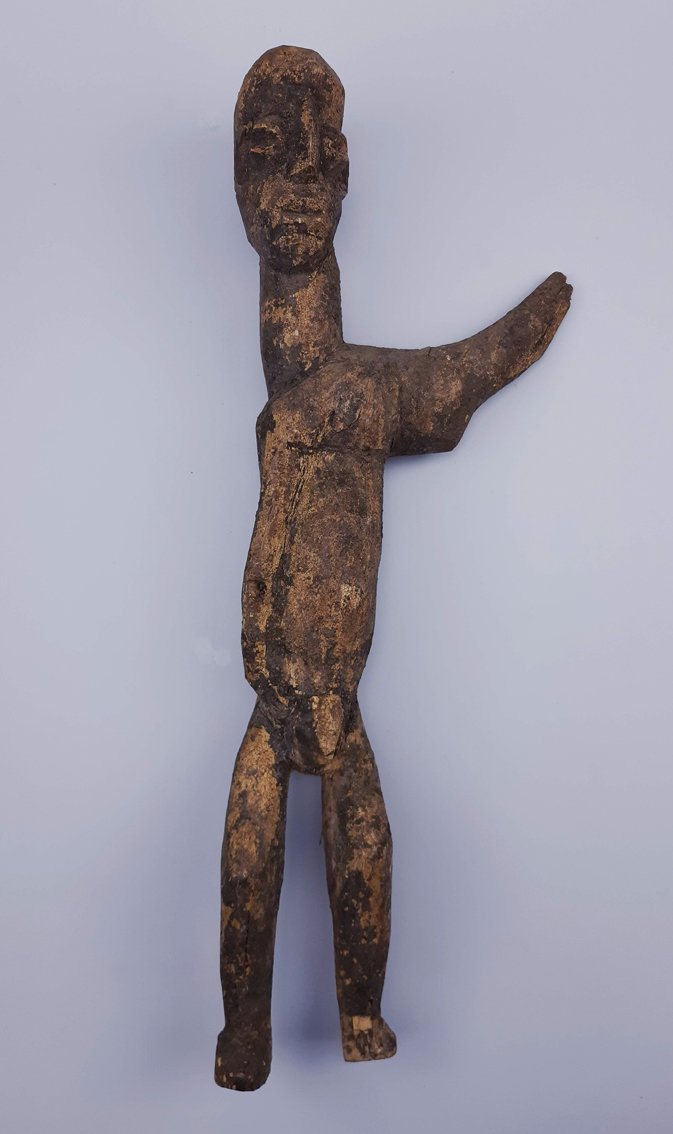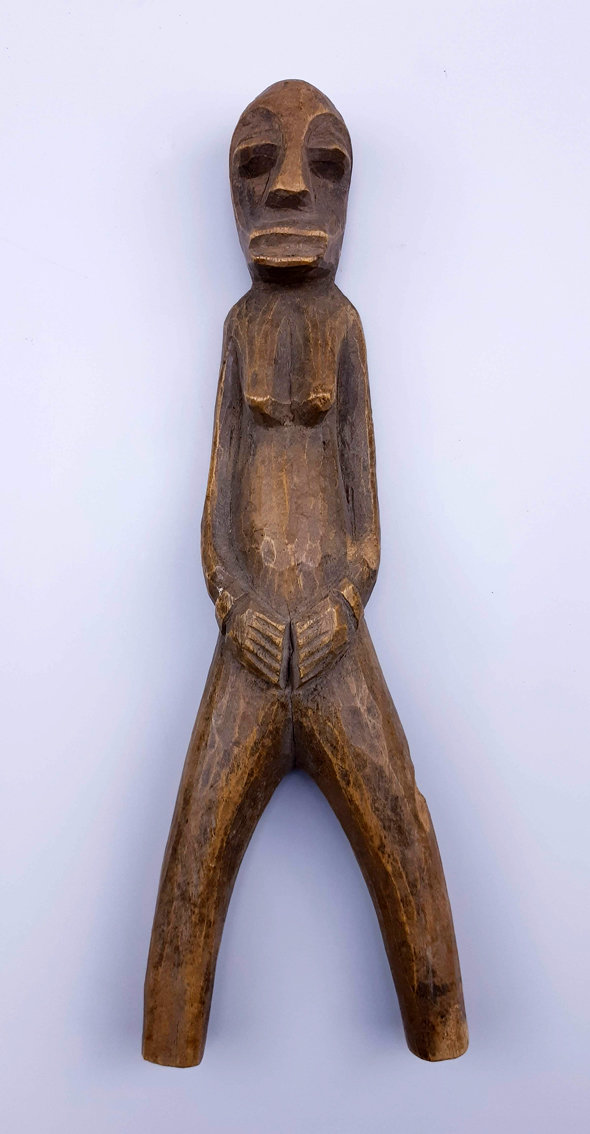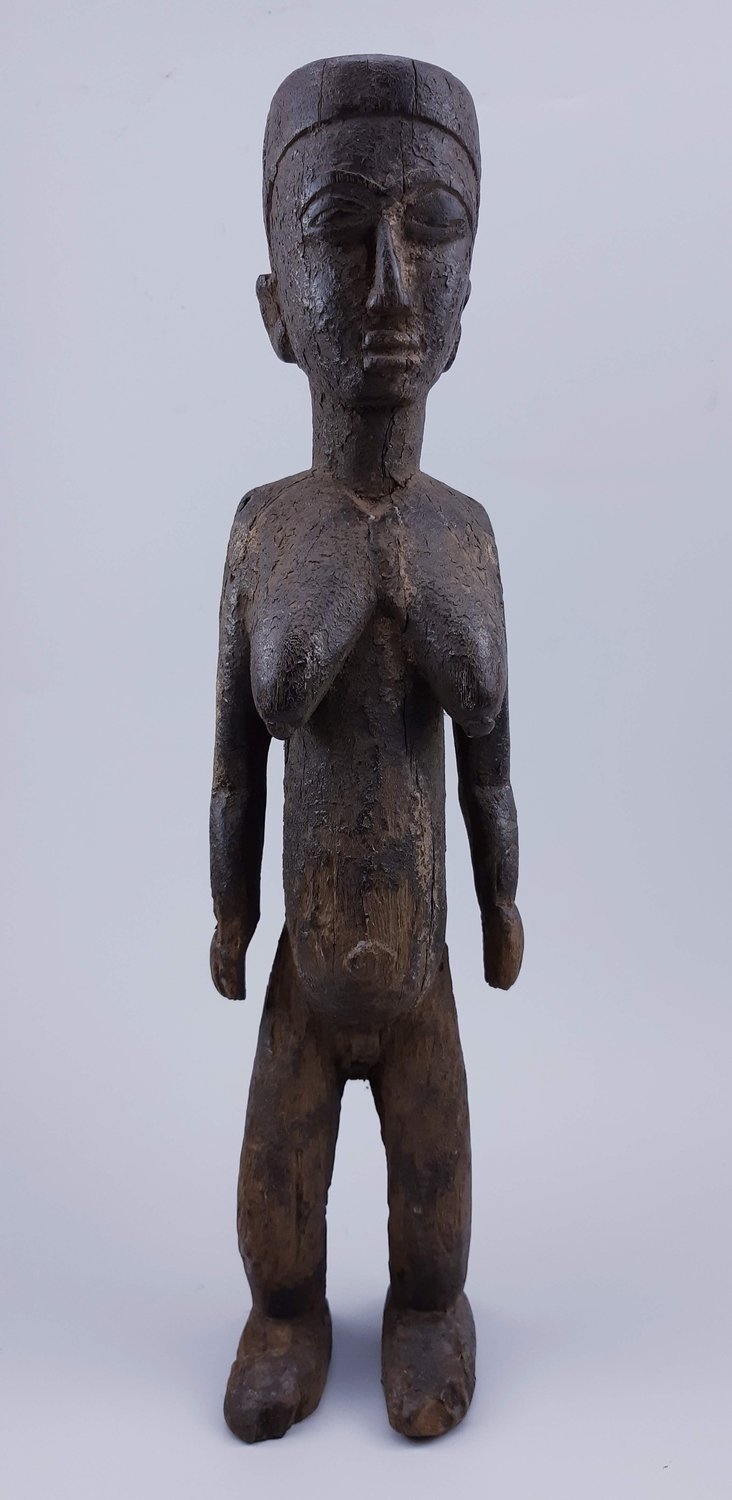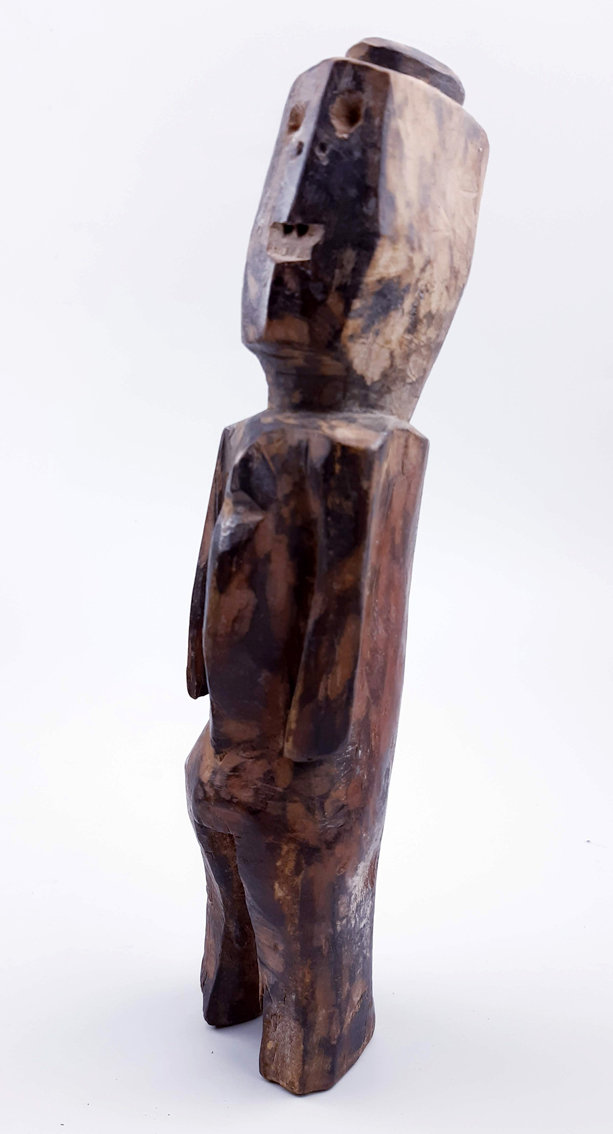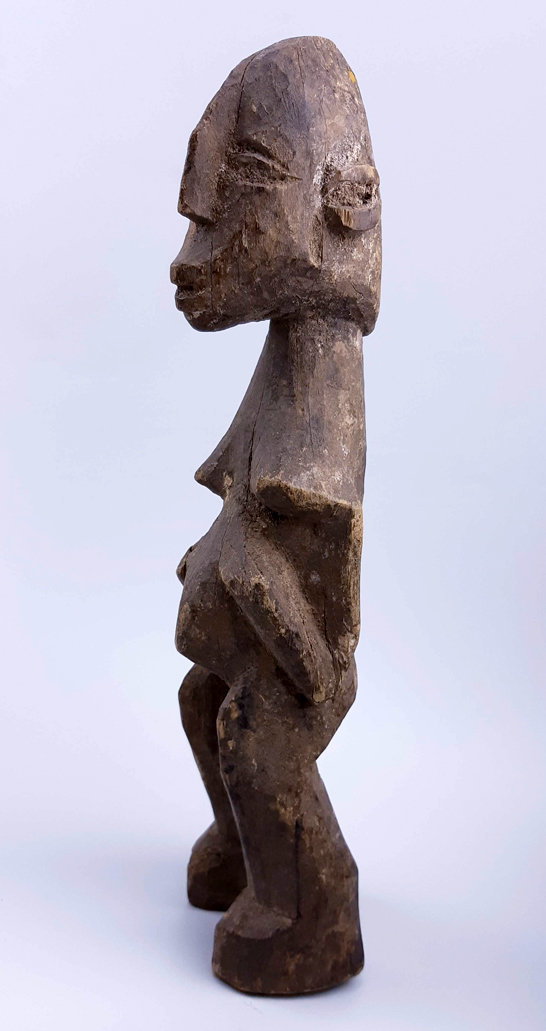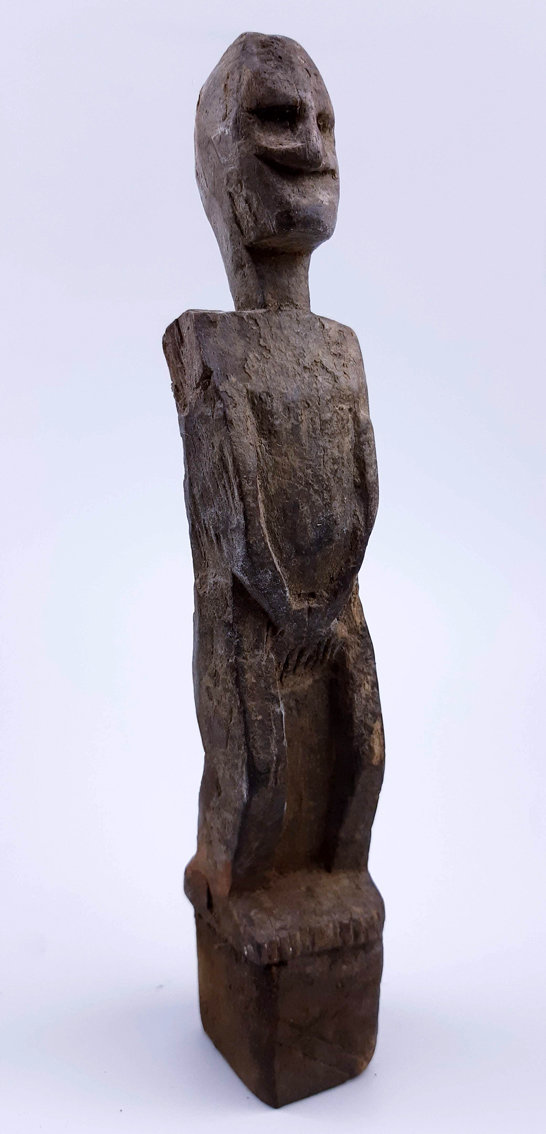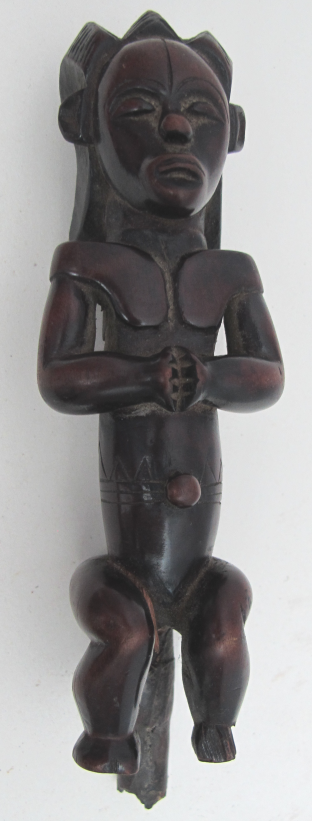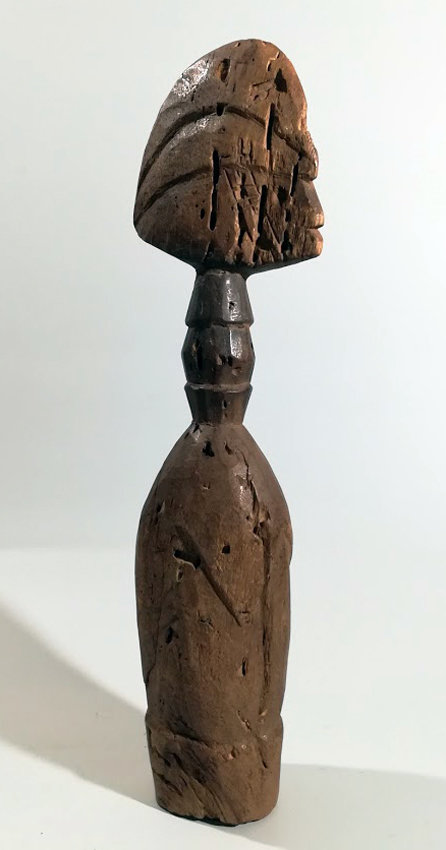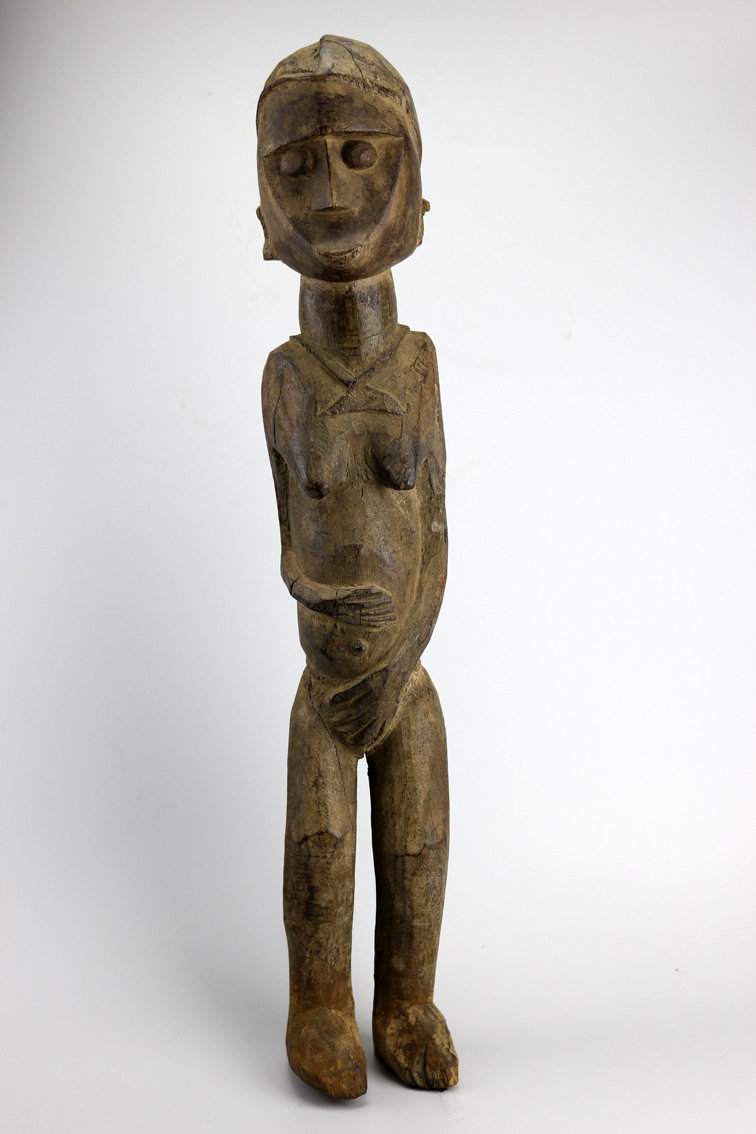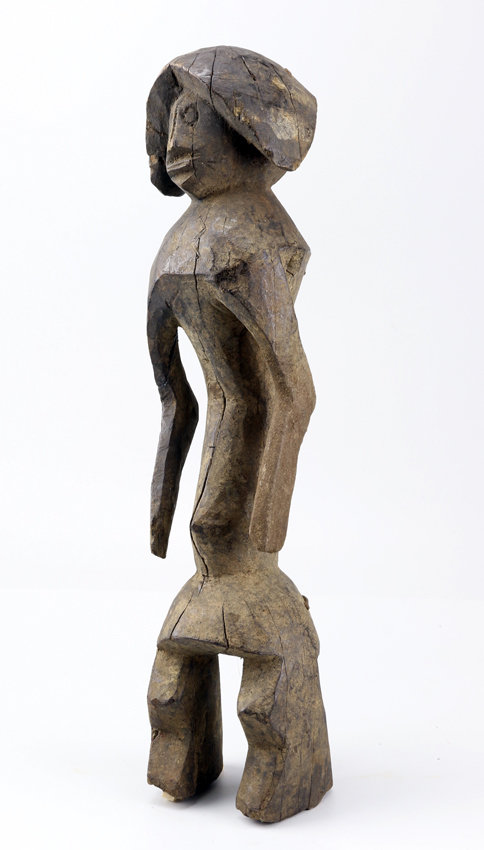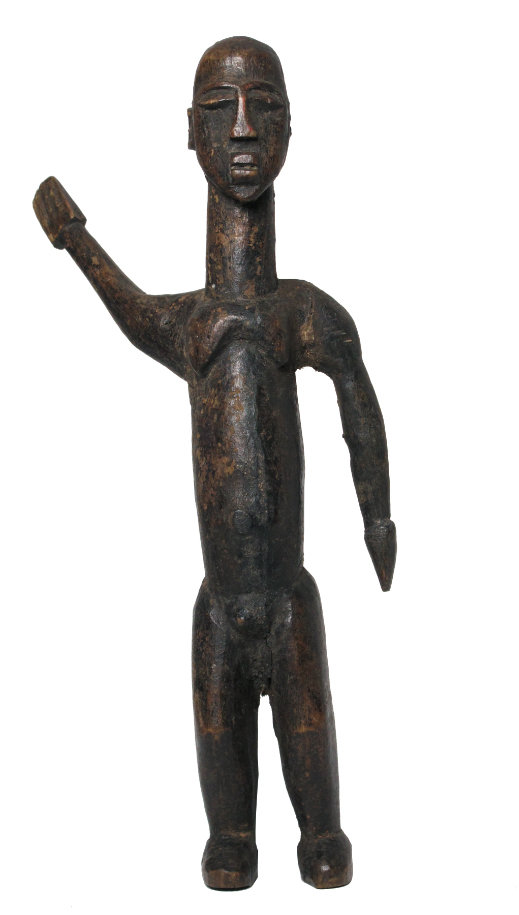- Vue Rapide
- Vue Rapide
-
Vue Rapide€1.200,00
Burkina Faso, Lobi Statuette
The Lobi live in southwestern Burkina Faso and northern Côte d’Ivoire and Ghana. they are extremely resistant to any form of centralized political authority. Instead their communities are based on the laws of God. The central figure in each Lobi community is the religious specialist named the Thildar. this soothsayer is responsible for communicating with the spirits that govern the community and protecting members of each family from accidents, illness, violence and all the multiple threats people encounter in the hostile environment of West Africa . The carved Lobi represent the spirits of nature they called Thil. Each of these figures displays different gestures or postures, some of them can have two or even three heads, some female figures carry a baby under the arm. These unique characteristics represent the particular talent or power of the spiritual being they embody. A figure raising an arm places a roadblock at the entrance of the malicious spirits at the family home.
***
The Lobi live in southwestern Burkina Faso and northern Ivory Coast and Ghana. they are extremely resistant to any form of centralized political authority. Instead of their communities are based on the laws of God. The central figure in every Lobi community is the religious scholar named Thildar. this diviner is responsible for communicating with the spirits that govern the community and protecting the members of each family against accidents, illness, violence and all the multiple threats people encounter in the hostile environment of West Africa. The sculpted Lobi represent the spirits of nature they called Thil. Each of these figures displays different gestures or postures, some of them may have two or even three heads, some female figures carry a baby under the arm. These unique characteristics represent the particular talent or power of the spiritual being they embody. A character raising an arm places a checkpoint at the entrance of malicious spirits at the family home.
***
Die Lobi leben im Südwesten von Burkina Faso und der nördlichen Elfenbeinküste und Ghana. Sie sind extrem resistent gegenüber jeder Form zentralisierter politischer Autorität. Statt ihrer Gemeinschaften basieren sie auf den Gesetzen Gottes. Die zentrale Figur in jeder Lobi-Gemeinschaft ist der Religionswissenschaftler Thildar. Dieser Wahrsager ist verantwortlich für die Kommunikation mit den Geistern, die die Gemeinschaft regieren und schützt die Mitglieder jeder Familie vor Unfällen, Krankheiten, Gewalt und all den vielfältigen Bedrohungen, denen Menschen in der feindseligen Umgebung Westaf. Die skoquerierten Lobi repräsentieren die Geister der Natur, die sie Thil nannten. Jede dieser Figuren zeigt verschiedene Gesten oder Haltungen, einige von ihnen können zwei oder sogar drei Köpfe haben, einige weibliche Figuren tragen ein Baby unter dem Arm. Diese einzigartigen Eigenschaften repräsentieren das besondere Talent oder die Kraft des spirituellen Wesens, das sie verkörpern. Ein Charakter, der einen Arm anhebt, platziert einen Kontrollpunkt am Eingang von bösartigen Geistern im Haus der Familie.
-
Vue Rapide€1.500,00
Burkina Faso, Lobi Statuette
The Lobi live in southwestern Burkina Faso and northern Côte d’Ivoire and Ghana. they are extremely resistant to any form of centralized political authority. Instead their communities are based on the laws of God. The central figure in each Lobi community is the religious specialist named the Thildar. this soothsayer is responsible for communicating with the spirits that govern the community and protecting members of each family from accidents, illness, violence and all the multiple threats people encounter in the hostile environment of West Africa . The carved Lobi represent the spirits of nature they called Thil. Each of these figures displays different gestures or postures, some of them can have two or even three heads, some female figures carry a baby under the arm. These unique characteristics represent the particular talent or power of the spiritual being they embody. A figure raising an arm places a roadblock at the entrance of the malicious spirits at the family home.
***
The Lobi live in southwestern Burkina Faso and northern Ivory Coast and Ghana. they are extremely resistant to any form of centralized political authority. Instead of their communities are based on the laws of God. The central figure in every Lobi community is the religious scholar named Thildar. this diviner is responsible for communicating with the spirits that govern the community and protecting the members of each family against accidents, illness, violence and all the multiple threats people encounter in the hostile environment of West Africa. The sculpted Lobi represent the spirits of nature they called Thil. Each of these figures displays different gestures or postures, some of them may have two or even three heads, some female figures carry a baby under the arm. These unique characteristics represent the particular talent or power of the spiritual being they embody. A character raising an arm places a checkpoint at the entrance of malicious spirits at the family home.
***
Die Lobi leben im Südwesten von Burkina Faso und der nördlichen Elfenbeinküste und Ghana. Sie sind extrem resistent gegenüber jeder Form zentralisierter politischer Autorität. Statt ihrer Gemeinschaften basieren sie auf den Gesetzen Gottes. Die zentrale Figur in jeder Lobi-Gemeinschaft ist der Religionswissenschaftler Thildar. Dieser Wahrsager ist verantwortlich für die Kommunikation mit den Geistern, die die Gemeinschaft regieren und schützt die Mitglieder jeder Familie vor Unfällen, Krankheiten, Gewalt und all den vielfältigen Bedrohungen, denen Menschen in der feindseligen Umgebung Westaf. Die skoquerierten Lobi repräsentieren die Geister der Natur, die sie Thil nannten. Jede dieser Figuren zeigt verschiedene Gesten oder Haltungen, einige von ihnen können zwei oder sogar drei Köpfe haben, einige weibliche Figuren tragen ein Baby unter dem Arm. Diese einzigartigen Eigenschaften repräsentieren das besondere Talent oder die Kraft des spirituellen Wesens, das sie verkörpern. Ein Charakter, der einen Arm anhebt, platziert einen Kontrollpunkt am Eingang von bösartigen Geistern im Haus der Familie.
- Vue Rapide
-
Vue Rapide€1.500,00
Les Lobi vivent dans le sud-ouest du Burkina Faso et du nord Côte-d’Ivoire et le Ghana. ils sont extrêmement résistants à toute forme d’autorité politique centralisée. Au lieu de leurs communautés sont fondées sur les lois de Dieu. Le personnage central dans chaque communauté Lobi est le spécialiste religieux nommé le Thildar. ce devin est responsable de la communication avec les esprits qui régissent la communauté et protéger les membres de chaque famille contre les accidents, la maladie, la violence et toutes les menaces multiples personnes rencontrent dans l’environnement hostile de l’Afrique de l’Ouest. Les Lobi sculpté représenter les esprits de la nature qu’ils appelaient Thil. Chacune de ces figures affiche différents gestes ou postures, certains d’entre eux peuvent avoir deux ou même trois têtes, quelques figures féminines transporter un bébé sous le bras. Ces caractéristiques uniques représentent le talent particulier ou la puissance de l’être spirituel qu’ils incarnent. Un personnage levant un bras place un barrage à l’entrée des esprits malveillants à la maison familiale.
- Vue Rapide
-
Vue Rapide€650,00
Le BYERI, culte des ancêtres, permettait aux vivants d’entrer en contact avec leurs défunts. Les rites étaient organisés pour obtenir leur protection avant toute décision essentielle touchant aux alliances, aux activités de subsistance, à la guerre et à la guérison. Des boîtes reliquaires, surmontées de figures en pied ou de têtes, constituaient les objets cultuels majeurs. Elles contanaient des crânes entiers ou des fragments, des os longs tels des tibias, et des dents, qui avaient été prélevés puis nettoyés quelques mois après le décès d’un parent important pour bénéficier de sa force vitale. On y mettait aussi des cauris et de petits éléments en fer, cuivre ou laiton. Lors de l’initiation des adolescents, les sculptures étaient désolidarisé du contenant. Elles participaient à une mise en scène qui permaittait aux novices de communiquer avec leurs ancêtres et de découvrir leur généalogie. Cette relation entre les vivants et les morts se renforçait grâce aux offrandes faites par l’officiant des cultes. L’aspect luisant des pièce donne l’impression que le bois suinte parce qu’il est saturé ; ce phénomène est dû aux matières les imprégant. Taillés dans un bois léger de couleur claire, ces sculptures étaient enduites de vase puis d’un mélange de charbon et d’huile de palme sans cesse renouvelé lors des rites. Les corps étaient par aillleurs solicité pour des soins thérapeutiques. Le nez et la bouche de certaines oeuvres ont été grattés. De petits prélèvements inorposés à deiverses substances étaient absorbés par les initiés pour se soigner ou pour se stimuler lors des rituels.
-
Vue Rapide€3.100,00The Ashantis are a West African population living in Ghana. They are part of the great group of Akans (the whole Akan world also extends to Ivory Coast where it includes interior or coastal ethnic groups) and are themselves subdivided into numerous subgroups. The Ashanti federation developed in the 13th century. The capital is Kumasi. In the 19th century, this civilization reached its peak and occupied almost 70% of present-day Ghana. The Ashanti community was the largest of all Akan states and the longest in time. Core of the Oyoko clan, Asantemanso remains their place of origin.The Ashanti were conquerors who divided up into groups and lived in small groups which formed vassal city-states of the Denkyira kingdom. The Oyoko will become dominant and impose themselves. Osei Tutu will be the first king to unify these groups. The empire was first continental then the year 1806 marks the beginning of the conquest of the coastal region. The English eventually annex Ghana. It will be the end of the Ashanti Empire.
-
Vue Rapide€5.500,00
Important Lobi statuette, Burkina Faso
The Lobi live in southwestern Burkina Faso and northern Côte d’Ivoire and Ghana. they are extremely resistant to any form of centralized political authority. Instead their communities are based on the laws of God. The central figure in each Lobi community is the religious specialist named the Thildar. this soothsayer is responsible for communicating with the spirits that govern the community and protecting members of each family from accidents, illness, violence and all the multiple threats people encounter in the hostile environment of West Africa . The carved Lobi represent the spirits of nature they called Thil. Each of these figures displays different gestures or postures, some of them can have two or even three heads, some female figures carry a baby under the arm. These unique characteristics represent the particular talent or power of the spiritual being they embody. A figure raising an arm places a roadblock at the entrance of the malicious spirits at the family home.
***
Important Lobi statuette, Burkina FasoThe Lobi live in southwestern Burkina Faso and northern Ivory Coast and Ghana. they are extremely resistant to any form of centralized political authority. Instead of their communities are based on the laws of God. The central figure in every Lobi community is the religious scholar named Thildar. this diviner is responsible for communicating with the spirits that govern the community and protecting the members of each family against accidents, illness, violence and all the multiple threats people encounter in the hostile environment of West Africa. The sculpted Lobi represent the spirits of nature they called Thil. Each of these figures displays different gestures or postures, some of them may have two or even three heads, some female figures carry a baby under the arm. These unique characteristics represent the particular talent or power of the spiritual being they embody. A character raising an arm places a checkpoint at the entrance of malicious spirits at the family home.
***
Wichtige Lobi Statuette, Burkina FasoDie Lobi leben im Südwesten von Burkina Faso und der nördlichen Elfenbeinküste und Ghana. Sie sind extrem resistent gegenüber jeder Form zentralisierter politischer Autorität. Statt ihrer Gemeinschaften basieren sie auf den Gesetzen Gottes. Die zentrale Figur in jeder Lobi-Gemeinschaft ist der Religionswissenschaftler Thildar. Dieser Wahrsager ist verantwortlich für die Kommunikation mit den Geistern, die die Gemeinschaft regieren und schützt die Mitglieder jeder Familie vor Unfällen, Krankheiten, Gewalt und all den vielfältigen Bedrohungen, denen Menschen in der feindseligen Umgebung Westaf. Die skoquerierten Lobi repräsentieren die Geister der Natur, die sie Thil nannten. Jede dieser Figuren zeigt verschiedene Gesten oder Haltungen, einige von ihnen können zwei oder sogar drei Köpfe haben, einige weibliche Figuren tragen ein Baby unter dem Arm. Diese einzigartigen Eigenschaften repräsentieren das besondere Talent oder die Kraft des spirituellen Wesens, das sie verkörpern. Ein Charakter, der einen Arm anhebt, platziert einen Kontrollpunkt am Eingang von bösartigen Geistern im Haus der Familie.
-
Vue Rapide€3.500,00
-
Vue Rapide
Bateba statuette of the Lobi people, Burkina Faso
The Lobi live in southwestern Burkina Faso and northern Côte d’Ivoire and Ghana. they are extremely resistant to any form of centralized political authority. Instead their communities are based on the laws of God. The central figure in each Lobi community is the religious specialist named the Thildar. this soothsayer is responsible for communicating with the spirits that govern the community and protecting members of each family from accidents, illness, violence and all the multiple threats people encounter in the hostile environment of West Africa . The carved Lobi represent the spirits of nature they called Thil. Each of these figures displays different gestures or postures, some of them can have two or even three heads, some female figures carry a baby under the arm. These unique characteristics represent the particular talent or power of the spiritual being they embody. A figure raising an arm places a roadblock at the entrance of the malicious spirits at the family home.
H. 25cm. Male character whose pose reflects the Lobi aesthetic in its quality criteria. Standing, the right arm raised back, the left arm stretched out along the body. The forehead is high, the flat nose triangular and the male torso well pronounced. Sex and navel are prominent. The muscular legs have powerfully shaped calves. Hard and dense wood, very nice patina of use.
***
Bateba statuette of the Lobi people, Burkina Faso.
H. 25cm. Male character whose pose reflects the aesthetic Lobi in its quality criteria. Standing, the right brad raised back, the left arm at a distance stretched along the body. The forehead is high, the triangular flat nose and the pronounced male torso. Sex and navel are prominent. The muscular legs have powerful patterned knobs. Hard and dense wood, very beautiful patina of use.
***
Bateba Statuette der Lobi Leute, Burkina Faso.
H. 25cm. Männlicher Charakter, dessen Haltung den ästhetischen Lobi in seinen Qualitätskriterien widerspiegelt. Der rechte Brad hob sich zurück, der linke Arm streckte sich in einiger Entfernung über den Körper. Die Stirn ist hoch, die dreieckige flache Nase und der ausgeprägte männliche Torso. Sex und Nabel sind prominent. Die muskulösen Beine haben kräftige gemusterte Knöpfe. Hartes und dichtes Holz, sehr schöne Patina.
